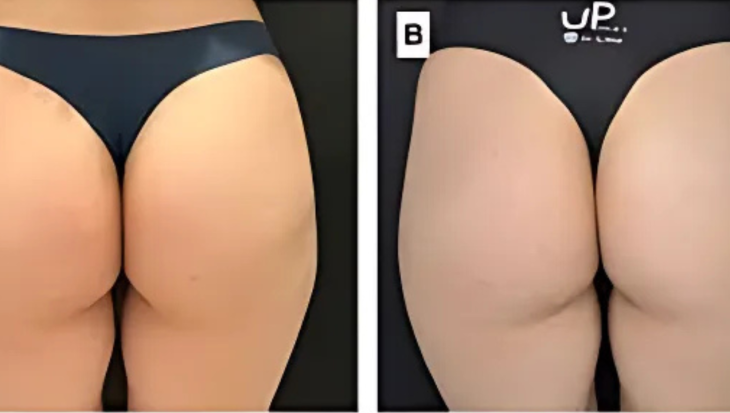When it comes to modern body contouring, more is no longer the goal — precision, proportion, and natural enhancement are. This shift has led to a growing preference for low-volume fat transfer in gluteal enhancement, especially among slim and petite individuals seeking a refined, balanced silhouette.
So, what are the benefits of low-volume fat transfer in glute enhancement?
Low-volume fat transfer offers safer, more natural-looking results by focusing on shape, lift, and symmetry rather than dramatic size — making it ideal for athletic, slim, and proportion-focused patients.
Let’s explore why this approach is gaining popularity, how it differs from traditional BBLs, and why it’s the preferred method for achieving authentic, long-lasting curves.
What Is Low-Volume Fat Transfer?
Low-volume fat transfer refers to the injection of 400–1,200 cc of fat into the buttocks — significantly less than the 2,000–3,000+ cc used in traditional BBLs.
This technique is the foundation of the Skinny BBL, a specialized procedure designed for:
- Petite body types
- Athletic or low-body-fat individuals
- Patients who want subtle, natural enhancement
Instead of aiming for extreme fullness, low-volume transfer focuses on:
- Lift and projection
- Improved waist-to-hip ratio
- Smooth, rounded contours
- Proportionate enhancement
It’s not about adding bulk — it’s about sculpting and refining.
Key Benefits of Low-Volume Fat Transfer
1. More Natural-Looking Results
Low-volume transfer creates curves that complement your frame rather than overwhelm it.
- Avoids the “overfilled” or “artificial” look
- Enhances your natural shape
- Ideal for patients who want to look feminine, balanced, and fit — not exaggerated
This is especially important for slim women who want curves that look like they belong on their body.
2. Higher Fat Graft Survival Rate
Smaller volumes of fat are easier for the body to support because:
- They require less blood supply to survive
- Are less likely to clump or compress surrounding tissue
- Experience less pressure and trauma during injection
As a result, fat survival rates with low-volume transfer often reach 60–70%, compared to 50% or lower in high-volume BBLs.
3. Reduced Risk of Complications
Injecting large volumes of fat increases the risk of:
- Fat embolism syndrome (FES) — where fat enters the bloodstream
- Overfilling and tissue necrosis
- Poor wound healing or seroma formation
By using smaller amounts of fat, low-volume transfer significantly reduces these risks, making the procedure safer and more predictable.
4. Better Suitability for Slim Patients
Many low-body-fat individuals simply don’t have enough donor fat for a traditional BBL. Low-volume transfer makes enhancement possible by:
- Maximizing the use of small fat reserves (from flanks, back, thighs)
- Using advanced techniques like VASER lipo and fat purification
- Focusing on quality over quantity
Even patients with 10–15% body fat can achieve beautiful results.
5. Shorter Recovery and Less Swelling
Because less tissue is manipulated, patients often experience:
- Less post-op swelling
- Reduced bruising and discomfort
- Faster healing
- Easier recovery — especially when avoiding sitting on the buttocks
This makes low-volume BBLs ideal for active individuals who want to return to daily life quickly.
6. Improved Shape and Symmetry
Low-volume transfer allows for greater precision in fat placement.
Surgeons can:
- Use multi-layer injection techniques for smooth transitions
- Focus on lifting the upper pole of the glutes for a perky look
- Correct asymmetry or flatness with strategic placement
The result is a more sculpted, lifted appearance — not just a bigger one.
7. Long-Term Proportion and Aging Gracefully
Extremely large BBLs can sag or distort over time, especially with weight fluctuations or aging.
Low-volume enhancements tend to:
- Age more naturally
- Maintain their shape longer
- Require fewer revisions
Patients report feeling more confident in their results years after surgery.
8. Ideal for Combination with Body Contouring
Low-volume BBLs pair perfectly with other sculpting procedures like:
- Lipo 360 – to refine the waist, back, and hips
- Hi-Def Liposuction – to etch muscle definition
- Emsculpt NEO – to build gluteal muscle under the fat
This creates a complete, harmonious transformation — not just isolated volume.
Who Benefits Most from Low-Volume Fat Transfer?
This approach is ideal for:
- Petite women and men with a BMI of 18–24
- Athletes and fitness enthusiasts with low body fat
- Patients who want natural curves, not dramatic augmentation
- Those seeking balanced proportions over size
- Individuals who prioritize safety and long-term satisfaction
It’s also a smart choice for first-time BBL patients who want to test the look before considering additional volume.
Final Thoughts
The rise of low-volume fat transfer in glute enhancement reflects a broader shift in aesthetic preferences — from extreme to elegant, from size to shape, and from trend-driven to timeless.
For slim individuals undergoing a Skinny BBL, this approach offers safer, more natural, and longer-lasting results — all while preserving the integrity of their frame.
When performed by a certified plastic surgeon experienced in body contouring for petite body types, low-volume fat transfer delivers beautiful, proportionate curves that look and feel authentic.
Ready to Achieve Natural Enhancement?
If you’re considering a Skinny BBL and want the benefits of low-volume fat transfer, start by connecting with verified providers in major cities like Los Angeles, Miami, Houston, and Dallas.
Our directory connects you directly with board-certified plastic surgeons experienced in the latest body contouring trends, ensuring you receive personalized, high-quality care tailored to slim and petite body types.
With the right guidance and expertise, your journey toward a naturally enhanced silhouette can be smooth, safe, and life-changing.






Leave a Reply